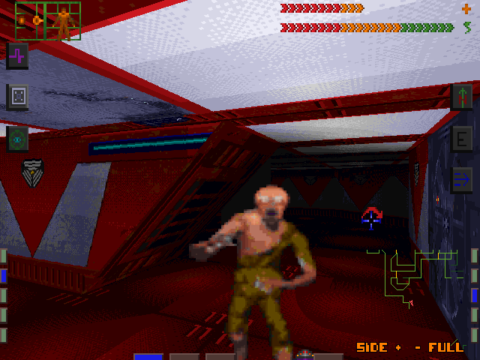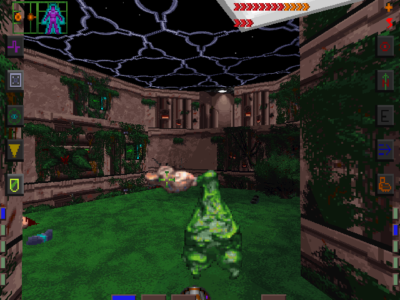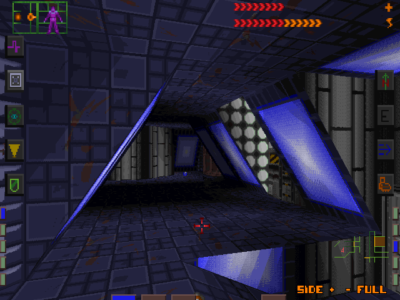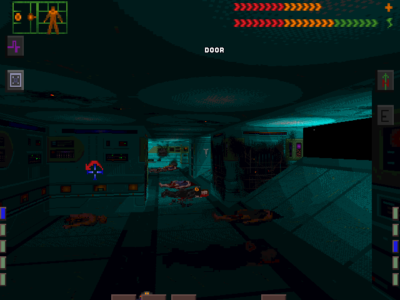
System Shock
Written by: Stoo
Date posted: October 24, 2001
- Genre: RPG
- Developed by: Looking Glass Studios
- Published by: Ocean
- Year released: 1994
- Our score: 9
Now this one is pretty important to FFG. In fact, It’s one of the reasons I started this site in the first place. I first bought a copy of Shock jointly with a friend, twelve or so years ago, and it became one of my all-time favourites. So I suppose I should come clean from the start; this is going to be a pretty favourable review. Still I’ll do my best to provide a rational assessment.
Shock was preceded in the Looking Glass lineup by Ultima Underworld, a first-person action-RPG. UU was noted for having a highly advanced engine for its time, more so than Wolfenstein 3D, the other major first-person action game of the day. However, it was Wolf3D with its fast-paced action, along with the help of shareware distribution, that gained public attention and iD that went on to be leaders of the genre. This trend would continue, with Shock itself being eclipsed by iD’s Doom. While there are reasons for this, Shock is to me the superior game.
Let’s start with the setting, a century or so in the future. It’s explained in a pre-rendered intro, the sort of thing I normally gloss over in reviews but this one really is well done by mid-90s standards. Your character is an elite hacker type a century or so in the future, who manages to break into the network of ruthless mega-corporation Tri-optimum. Which isn’t a grand idea, really, as we all know what ruthless mega-corporations can be like. He’s promptly arrested by their private security forces and hauled off to Citadel Station, a major facility in orbit over Saturn. There he’s offered a deal by a shady high-level executive. If he hacks the artificial intelligence controlling the station known as Shodan, and hands control to the exec, he’ll be let off the hook. What’s more, he’ll be surgically implanted with a cybernetic interface to give him even more awesome powers of hacking.
So the hacker does the deed, gets his reward and awakes from a healing coma a couple of months later. That’s where you take over, to discover the consequences of the hacker’s actions. Namely, that freed from her previous constraints, Shodan has embarked on a mission to exterminate humanity. The crew are all dead or missing and her cyborg minions roam the station. Worse, she’s turning her resources, like a huge mining laser and biological weapons, towards earth itself. Ooops.
So welcome to System Shock, once referred to as “The Thinking Man’s Doom”. It’s a first-person shooter at the most basic level, just like iD’s classic. However it represents a rather different approach to the genre. Doom chose to keep it simple: you dash about, shoot demons in the head, hunt for keys, hit a switch at the end of the level. Then repeat. It worked, Doom was immensely successful and for a few years after most shooters were happy to keep to the same pattern. Shock, however, has more to it than just running and gunning; it’s a game of greater depth. For example as described an actual story – featuring a well-written and chilling foe – and also mission-based objectives.
What we’ll look at first, though, is the technology it all, and the capabilites of your character. Shock’s engine was you see pretty advanced for its day. It could do slopes, which was beyond the Doom engine. Also it could do “proper” tilting of the player view up and down – other pseudo-3D games of the time either didn’t offer that, or faked it with a skewing effect that looked kind of weird. Another very welcome feature is the ability to not only jump but also climb onto ledges and haul yourself up – being stopped by four-foot walls in other games was always ridiculous. On top of that is a half-decent physics model that lets you pick up objects and throw them around with varying levels of force. Not only can you toss grenades but also random junk, just for the hell of it.
Here’s the downside: the engine always felt slow. At its highest settings of 640×480 SVGA, it lurched along even on a machine considered powerful in the day. Also for a modern gamer the controls are, whilst more powerful than other shooters of the time (with crouching and leaning options), clunky. There’s no mouselook as we know it today where the mouse controls the direction you face. Instead it moves the position of the crosshairs on screen, while to actually turn or look up you use keys. So it can be a finger-twisting exercise sometimes – and you can’t remap the controls to anything more comfortable. It’s fortunate really that Shock lends itself to a slow and cautious approach, which somewhat mitigates the effect of these annoyances.
Anyway, the technology is put together with solid design work to create some pretty great environments. Importantly, Shock took some steps towards locations that look like they have an actual purpose. Well, to be fair there are still a whole lot of random corridors. In places though you get recognizable places like offices and medical labs, which helps make Citadel more convincing as a place people once lived and worked in. Being able to interact with items like numerical keypads and power-recharging stations helps too, along with the aforementioned items you can actually pick up.
There are multiple decks to the station, each with its own designated purpose and corresponding style. So the medical deck is in shades of cold blue, whilst the executive level features plush offices and conference rooms. The reactor level feels cramped and dirty, all ducts and machinery. There are even some garden groves, which have gotten over-run with Shodan’s biology experiments – but a nice feature is that you can climb many vine-laden walls. Each deck is quite open in plan; you’re not funnelled around Half-life style but rather can explore freely. You also move back and forth according to objectives, and may at points find levels re-populated with new scarier enemies.
Talking about the environments leads towards one of the key points in Shock, which is the sense of atmosphere they carry. It’s creepy and moody, a claustrophobic world now devoid of the living breathing people who should be walking its corridors, and now under the command of a malign unseen entity. The experience isn’t about constant guns-blazing action, but rather uneasy tension. Moving cautiously through dimly lit corridors, picking your way across bodies whilst clutching a pistol and worrying about that chattering noise in the distance, now that’s what Shock is about. It’s a great game for playing at night, with headphones on, jumping at noises in the dark and feeling just a bit disturbed.
To help set the scene, you can pick up diaries and journal entries recorded by the crew before their deaths. Through these a story of the disaster unfolds, from the perspectives of over a dozen people over several months. If you have the CD version of the game the entries are spoken, and the voice acting is pretty good. It’s a clever way of giving the player some emotional attachment to the story, without ever actually interacting with anyone. You hear routine grumbles about working the late shift, then confusion over incidents like malfunctioning robots, and finally fear and despair as Shodan’s terrible legions hunt the crew down. There are accounts of desperate resistance movements, and people yelling as gunfire rattles in the background. Now some of these voices are the corpses littering the corridors around you, and others suffered an even worse fate. All because of a disaster you played a part in. It’s quite poignant.
Shodan does herself address you directly on several occasions. She’s a voice in your head, mocking and taunting you as a “pathetic creature of meat and bone”, promising you a painful death when her minions find you. She has no physical preference, no body you can shoot, she’s just a force commanding the world around you. Your overall mission here is to thwart several of her plans to devastate the earth, leading to her becoming ever more frustrated with this little insect of a man flitting around within her domain. Her utter lack of compassion or empathy for the human race, coupled with delusions of godhood, marks her as one of gaming’s great villains.
It’s also worth mentioning the soundtrack, with each level of the station having its own theme. Some are minimalist, an ominous heartbeart which suits locations like the reactor level. Others are more fully featured, with haunting and evocative melodies. It’s all done via FM Synthesis, where a chip on your soundcard generates the music in realtime (or Dosbox simulates the effect). So it is a a bit basic in technical terms compared to what can be pre-recorded in a musician’s studio. Still it does a great job in enhancing the ambiance aboard Citadel.
I’ve talked a lot about the psychological experience of being the hacker, and how the scene is set to accomplish that but I should discuss some of the action as well. Your enemies come in three types; robot, mutant and cyborg. They’re represented by sprites, as was standard for the day. They’re pretty dumb too – enough so to fall into pits whilst blindly walking towards you. They do still work effectively enough though as threats in the dark places. Robots clank and whir before letting rip with machineguns, and it’s almost a mercy to put down the twisted screeching mutants. Cyborgs are especially grotesque; parodies of the human form created from former station crew and forced to serve Shodan. It’s satisfying to rifle their bodies for supplies, though.
You have a wide selection of guns available to do this with – pistols, automatic weapons and also phaser-beam types. As an interesting aside, this is the first shooter I know of to use the concept of ammo coming in discrete clips. A few weapons are oriented towards a certain type of enemy – the magpulse gun for example wrecks robots but us about as much use as a rolled up newspaper against mutants. As for grenades, i’ve already mentioned the throwing system, although dodgy collision detection means that throwing these around corners can occasionally be a risky experience. I know I suffered a few cases of death-by-own-grenade rage, causing much swearing. Oh, but if one bounces back into your face off a closing door, that’s just your own fault. Idiot.
Other toys include a bunch of hardware upgrades you can pick up. These vary in usefulness – the force field and night vision at least are well worth it. The rear-view vision sounds like a cool concept, but i did find it disorienting. The rocket boots pretty much just fling you into a wall, although they do have an incongruous but handy secondary mode as roller skates. In any case though, these gadges do add an extra dimension to the experience. There’s a feeling of becoming something of an enhanced cyborg yourself: you can hover a bit, fend off bullets, you have target analysers built into your display etc. It’s very appropriate to the cyberpunk themes of the story.
Also the game actively encourages you to take drugs. No, really, there are several different types, most with a boost to your abilities but also unfortunate side effect. Again a few are kind of useless. One boosts stamina, which is a nearly-irrelevant gameplay feature anyway; I never sprinted and jumped enough to get tired in the first place. The berserker patch is fun though: it greatly increases you strength with melee weapons, but makes you see in trippy psychedelic colours as you bash some robot to bits with a lead pipe.
Important also to the cyberpunk theme are features relevant to your status as a hacker. One comes in the form of using special access panels, to open a door or something similar. This is implemented in the form of a little logic puzzle on your interface – so it stretches your mind a little and helps with the sense of an interactive world. There are also points where you enter Cyberspace – here you’re basically floating in a surreal world of stark wireframe geometry, looking for bits of data or switches to unlock access to some part of the station. You must also fend off weirdy floating faces that represent software defences. Some people found these parts frustrating, and they can’t be skipped, but they do at least have a separate difficulty setting that can be cranked right down.
This I know is a rather glowing review. So in an effor to be, ahem, fair and balanced: here’s one over-arching crticisim. Early in the game, your resources are limited. A pistol or two, a few clips of ammo, a couple of healing patches. That’s a big part of what makes you feel vulnerable, which is an essential part of the Shock vibe. Later on though, it starts to more or less rain ammo on you, to the point where you’re staggering around under the weight of dozens of clips. I find Shodan is diminished a little, when you can hose her minions liberally with bullets and toss grenades about like apples.
Time to sum up. I’ve mentioned Doom a few times – iD’s title certainly nailed down the fast-paced action, and was good at what it aimed for. Shock however remains the greater work in my book – and greater also than many of the games that came over the following few years. That’s because there’s more depth to it than just the visceral thrills of blasting. Looking Glass aimed to provide a truly convincing and immersive sci-fi thriller experience. They wanted the player to feel they were really there in the role of that one man, all alone, fearfully intruding on the eerie and lethal domain of a mad goddess. Shock has fantastic atmosphere, a story to lend it purpose at a time when most shooters couldn’t really be bothered, and an environment that “feels” more real than any other game of that period. I can’t help wondering how the genre would look today if Shock had emerged more popular than Doom.
Taking off my nostalgia goggles, I have to admit it can be harder to get to grips with nowadays. It’s a pain to get running in the first place, the controls as mentioned don’t do it any favours and let’s be honest, it’s harder to be scared of blurry sprites than it was in 1994. It also has a sequel that’s pretty excellent, further develops some of the ideas, and does so with a much less creaky exterior. However if you can manage with the annoyances, Shock’s can still be highly engrossing. You could be lost for hours exploring the depths of Citadel Station: seeking to access some new area, or strike another blow against Shodan, or uncover more of the story of what took place there. So that’s my official line: the relative intellectual of the mid-90s shooters was the best of the crowd, and is still worth playing today. If I’ve sounded too fanboyish then, well, maybe I can bribe Rik into doing a 2nd opinion one day…





 Posts
Posts
System Shock is now available from GOG (gog.com), and is even Windows compatible now! Though if you prefer, you can install it to DOS or DOSBox, using the files from GOG.
The Windows version has updated and configurable controls and real mouse-look, along with a few other improvements, and you can download all of the mods if you want to use them with the DOS version of System Shock, from https://www.systemshock.org/index.php?topic=211.msg91880
GOG also sell System Shock 2 now, a fantastic follow up, a very deep RPG/FPS survival horror type game for Windows
October 20, 2015 @ 6:04 pm
Hi, we mentioned that in a recent post but thanks for the reminder, I should update this article!
October 21, 2015 @ 8:02 am
Now available on Steam as well.
October 25, 2015 @ 8:54 am